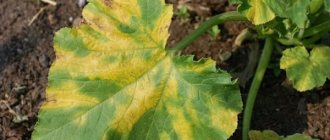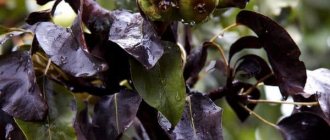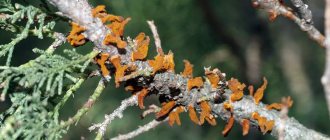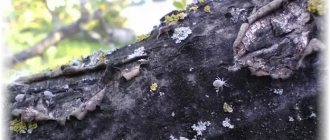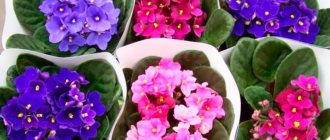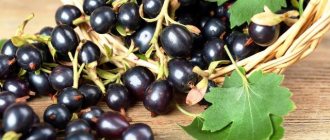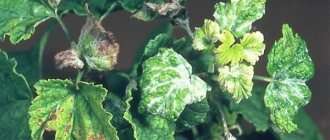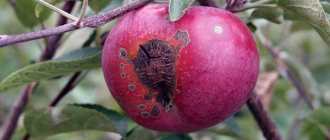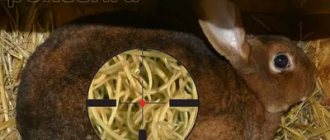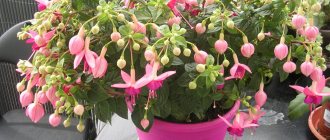Anthracnose is a disease caused by the fungi Gloeosporium, Kabatiella and Colletotrichum. Vegetable crops, berry bushes and fruit trees can suffer from this disease. Most often, characteristic symptoms appear on plants whose immunity is severely weakened. Both obvious damage (wounds, cracks) and signs of wilting become a significant cause for concern.
The situation is complicated by the fact that it is impossible to prevent the entry of spores into a personal plot. They are carried by water, wind and insects. Excessive soil and air moisture becomes a provoking factor. The risk of the disease increases due to high levels of acidity, sudden changes in temperature, and lack of minerals, in particular phosphorus and potassium. Also, we must not forget about the proximity of diseased plants.
Features of the disease anthracnose
Those plants that are weakened or have mechanical damage are most susceptible to anthracnose. The spread of the disease occurs through infected seed material, as well as plant debris. Spores are carried from one place to another by insects, wind and raindrops. The most active development of the disease is observed at high air humidity.
First of all, anthracnose affects the foliage; brown-red spots appear on its surface with a border of a darker shade or light yellow color. Over time, the spots increase in size and merge with each other. Depressed areas form on the surface of branches and shoots, which impede the movement of nutrients. These brownish, oblong-shaped spots increase in size over time, and they also deepen, darken, and a dark purple or brown rim appears around them. If the weather is dry, then many cracks appear on the surface of the affected areas. And with high humidity, rot forms in these areas, which leads to breaking of the stem or shoot at the site of the lesion. If the bush is not treated, its foliage will turn brown and dry out, and this will also lead to the death of the entire above-ground part of the crop.
Anthracnose develops very quickly at high levels of air humidity, for example, if it is cool outside (about 22 degrees) and the humidity level is 90 percent. The development of the disease is also facilitated by the low content of phosphorus and potassium in the soil, and its high acidity.
Description of the disease
Kabatiella, Gloeoporium, Colletotrichum - these three types of fungi cause a disease in which the leaves, shoots, and fruits of the plant are affected. Anthracnose is common in hot climates. But in addition to high temperatures, the fungus needs high humidity for active development.
Ask and receive useful advice from professional gardeners and experienced summer residents.>>
In recent years, the disease has been spreading in central Russia and some regions of Belarus. The main range is in the southern territories of the Russian Federation, Moldova, and Central Asia. The fungus produces up to 25-30 generations of spores during the summer season, is resistant to low temperatures and heat, and can survive in the form of mycelium for up to 4-5 years.
Treatment of anthracnose
Since anthracnose is a fungal disease, fungicides are used to combat it. If obvious signs of anthracnose damage have already been detected on the bush, then to combat it, the most commonly used means are: Oxychom, copper oxychloride, Previkur, Fundazol, Kuproxat, Acrobat MC, Ridomil Gold or Skor. These drugs cope very effectively with this disease, but in order to cure the plant, it will have to be treated twice or three times with a break of 1.5–3 weeks. In order to contain the development of the disease, microbiological agents such as Fitosporin-M and Gamair are used.
But almost every gardener and gardener knows that it is much easier to prevent a plant from getting anthracnose than to cure it later. That is why preventive measures to protect various crops from this disease should not be neglected.
Disease prevention
Pathogens can enter a garden or vegetable garden along with seeds, water for irrigation, garden tools, and various insects are their carriers. With increased humidity, pathogenic microorganisms are activated, and the rapid development of the disease begins.
For prevention purposes, strictly adhere to the rules of crop rotation, do not forget to disinfect the seeds before sowing, and in the autumn, clear the area of plant residues and dig up the soil. Gardening tools should always be clean, and pruning, dividing plants and grafting should only be done with previously sterilized tools. In addition, at the very beginning of spring before sap flow, as well as in autumn after leaf fall, treat the bushes with Topsin-M solution, and it must be mixed with a growth stimulating agent, for example, Epin, Zircon or Immunocytophyte.
Red burn
The causative agents of the disease are fungi of the genus Staganospora. Bulbous and hippeastrum are affected.
Signs of the disease.
Narrow reddish spots form on peduncles and leaves. Subsequently, crusts of spores appear in these places. The scales of the affected bulbs turn completely red. Leaves and buds are deformed, flowering is delayed or completely absent, bulbs rot and die.
Treatment of red burn.
Bulbs must be treated with one of the following fungicides:
| Drug name | Amount of drug | Amount of water (l) |
| Vitaros | 2 ml | 1 |
| Oksikhom | 4 g | 1 |
| Benomyl | 1 g | 1 |
This may be interesting: Blackleg - combating the disease
Anthracnose on garden crops
Anthracnose of cucumbers
In cucumbers, shoots, fruits and foliage suffer due to anthracnose. At the same time, symptoms of the development of the disease can be detected already in the seedling period: in the area of the root collar of the seedlings, depressed brown spots appear, over time they become ulcers, due to which the young plants lay down. In adult bushes, the leaf plates are first damaged by the disease; pale yellow or brown spots 3–30 mm in size appear on their edges. In bushes growing in a greenhouse, leaf tissue falls out from the center of the spots and round holes appear. In cucumbers in open ground, these spots have a slit-like shape. After anthracnose affects the leaf blades and shoots, the disease spreads to the fruits; oblong depressed areas of a pale pink or brownish hue are formed on them, they go 0.3–0.4 cm deep.
In order to cure bushes that are affected by the disease in the root area, they are watered at the root with Abiga-Pika solution (0.5%) or Bordeaux mixture (1%), before doing this, moisten the soil well. If necessary, you can process cucumbers in this way 2 or 3 times every 7 days, but make sure that the solution does not get on the surface of the leaf plates. To spray the affected foliage, use a solution of Polyram or Copper Oxychloride, and be sure to follow the instructions. To get rid of anthracnose, you can use products such as Thiovit Jet, colloidal sulfur or Cumulus. Also quite effective in the fight against anthracnose on cucumbers are: Strobi and Quadris.
CUCUMBER LEAVES getting stained and dry? Diagnosis and treatment in 5 minutes!
Anthracnose of tomatoes
Most often, adult tomato bushes become infected with anthracnose. First, the upper leaf blades wilt, spots form on their surface, on which small black sclerotia form. On the surface of unripe fruits, depressed areas of dark color appear, which reach up to 10 mm in diameter. Over time they become soft and black. As a result, mummification of the fruit occurs, as well as maceration of the root system, due to which the bush can be easily pulled out of the soil. The disease usually appears in the last summer or first autumn weeks. If the damage is widespread, then you can lose more than half the crop.
Breeders have bred hybrids that are highly resistant to anthracnose, for example, Long, Shelf or Life. However, even if you grow varieties that are not resistant to this disease, timely preventive measures will help protect tomatoes from being affected by the disease:
- adhere to the rules of crop rotation;
- before sowing, treat the seed material in a solution of Immunocytafit or Agata-25;
- adhere to agrotechnical culture rules;
- carry out preventive treatment of tomatoes in a timely manner with a solution of Quadris or Strobi.
If the plants are still affected by anthrocnose, they can be cured using drugs such as: Tiovit Jet, Polyram, Cumulus-DF, as well as Bordeaux mixture, colloidal sulfur or copper oxychloride (treatments are carried out in accordance with the instructions indicated on the package).
SUPER MIXTURE No. 1-c for TOMATOES and CUCUMBERS from PHYTOPHORA, ANTHracnose, PERONOSPORASIS + FEEDING
Potato anthracnose
In potatoes, anthracnose affects shoots and tubers. Brownish spots form on the surface of the stems; after a while, the shoots become angular and shortened, while chlorosis appears on the lower leaf blades. If the weather is dry, then the affected bushes begin to dry out, and with increased air humidity, the shoots become soaked, rot and become slimy. Vague spots of a dark brown hue form on the surface of the tubers; wet rot develops in them during storage.
In order to protect potatoes from damage by anthracnose, it is necessary to adhere to the rules of crop rotation; for this, such a vegetable is grown in the same area once every 3 or 4 years. For planting, you need to choose absolutely healthy tubers, which are treated with the fungicidal drug Maxim before planting. Throughout the season, do not forget to promptly remove weeds from the site, especially those belonging to the Solanaceae family. When the harvest is harvested, clear the surface of the soil in the garden from plant residues, while digging the soil deeply or plowing it. During storage of tubers, in order to contain the development of the disease, the air temperature in the storage should be about 1–3 degrees.
Anthracnose of zucchini
All above-ground parts of the zucchini bush can be affected by anthracnose. Brownish-yellow spots appear on the surface of the foliage, and depressed areas are formed on the fruits and shoots, which are covered with a pink coating. The root part of the bush, which is affected by anthracnose, most often dies.
In this case, the disease begins to actively develop at high air and soil humidity, and even when the bushes are watered in the heat. As soon as the first symptoms of the disease are detected, spray the bushes with a solution of colloidal sulfur (5-6 grams per 1 liter of water); instead, you can use Bordeaux mixture (1%). To prevent anthracnose you need to:
- adhere to the rules of crop rotation;
- carry out pre-sowing seed treatment;
- be sure to thoroughly inspect the seedlings before planting them in the garden;
- carry out weeding on time;
- after harvesting, clear the area of plant debris;
- in autumn, carry out deep digging of the soil;
- systematically disinfect the greenhouse.
Anthracnose on shrubs and trees
Currant anthracnose
Currants are quite often affected by anthracnose. Initially, small brown spots appear on the lower leaf blades, reaching approximately 1 mm in diameter. Over time, the spots increase in size and merge with each other. As the disease progresses, the foliage dries out and falls off. Depressed spots appear on the surface of green stems and petioles, which over time turn into wounds. Single whitish ulcers also form on the fruits. In the second half of summer, only a little young foliage remains on the affected bushes. It has been observed that red currants are more susceptible to anthracnose than black currants. The disease develops most actively during prolonged rains.
In order to save currants from anthracnose, you need to adhere to the following rules:
- In autumn, the area is cleared of flying leaves and plant debris remaining after pruning, which must be destroyed, since they are considered the main source of infection. Shrubs, as well as the surface of the soil around them, are sprayed with a solution of DNOC (1%) or Nitrafen (3%), after which the ground is dug up. Before the buds swell, re-treat with the same means.
- As soon as the bushes fade, or half a month after the first harvest of the fruits, for preventive purposes, spray the currants with a solution of Bordeaux mixture (1%) or a suspension of Zineb, Captan, copper oxychloride, which is prepared exactly according to the instructions indicated on the package. To cure anthracnose, you can use the following fungicidal agents: Cumulus-DF, Tiovit Jet or colloidal sulfur.
- Experts advise replacing ordinary currants with varieties that are resistant to anthracnose, namely: red currants - Bessemyanka, London Market, Chulkovskaya, Dutch red; black currants - Golubka, Velvetnaya, Kryzhovichnaya, Stakhanovka, Altaiskaya and Katun.
Gooseberry anthracnose
Since currants and gooseberries are closely related, the manifestation of anthracnose on these shrubs is no different. Therefore, it is necessary to fight this disease on gooseberries using the same methods and means as when currants are affected.
Raspberry anthracnose
In affected raspberry bushes, small round-shaped spots of brownish-gray color with a dark red border form on the foliage. Over time, the spots become larger and gradually merge with each other. Deep but small ulcers form on the surface of the affected stems. Affected flower shoots, stem tips and flowers dry out, and fruit mummification is observed.
In order to avoid damage to raspberries by anthracnose, experts advise purchasing those seedlings that are resistant to this disease. When planting bushes, be sure to maintain the distance between them that is recommended by experts. Remember, low-lying areas are not suitable for growing such a shrub, and it also needs the correct watering regime.
To cure raspberries affected by anthracnose, you need to cut out all diseased branches as quickly as possible, and treat the bushes themselves with a solution of a fungicidal drug. However, it is much easier to prevent the development of the disease; for this, carry out preventive treatments in a timely manner: the first spraying is at the beginning of the spring before the buds open, the second is a week and a half after the first treatment, the third is immediately after harvesting the fruits, the fourth is in the autumn, when it ends leaf fall For treatment, you can use a fungicidal agent such as a solution of copper oxychloride (5 grams per 1 liter of water) or Bordeaux mixture (1%).
Mildew and Anthracnose, two diseases - one treatment
Anthracnose of grapes
Grapes, compared to the described crops, are less susceptible to anthracnose, but they can suffer greatly from this disease. Varieties resistant to mildew and oidium are most susceptible to this disease, since they are not sprayed with fungicidal preparations. The most resistant to this disease are the following grape varieties: Sauvignon, Rkatsiteli, Traminer and Riesling.
The development of the disease is observed on all green parts of the bush, since only young tissues are affected by anthracnose. The foliage is affected by the disease only up to 25 days of age, the stems until they become lignified, and the fruits before they begin to ripen. Pale gray spots with a light red or dark border form on the affected foliage. Over time, the stains become larger and the fabric inside the headbands falls out. Brown spots appear on the stems, which after a while become deep coffee-colored sores with a dark purple border. If the grapes are very badly affected, then their stems become black, as if charred, and they become very fragile. The foliage on them becomes smaller and becomes chlorotic. Sores also appear on the inflorescences, then they dry out, as well as partial or complete death.
Affected bushes are sprayed with a solution of Bordeaux mixture (1%). The plants should be treated with a fungicidal preparation for the first time in the spring after the length of the young shoots is 10 centimeters. The following remedies fight this fungal disease very effectively: Previkur, Ordan, Acrobat, Abiga-Pik, Fundazol, Skor, MC and also copper sulfate. The plants are sprayed systematically with a break of 15 days. If it rains after treatment, you need to do it again. Experts advise alternating medications, otherwise resistance (addiction to the drug) may develop. Before spraying the bushes, cut and burn all diseased areas.
Grape diseases. Anthracnose. Grapes 2021.
Anthracnose of strawberries (strawberries)
If garden strawberries are infected with anthracnose, the gardener can lose up to 80 percent of the fruit. In this case, the disease is dangerous because it destroys the plant, but for a long time the symptoms of anthracnose may not appear at all. Anthracnose affects all above-ground parts of the bush. On the upper part of the leaf blades and on the tendrils, depressed small spots of a brownish-red color form, which eventually become ulcers. Over time, they increase in size and merge with each other, covering large areas, causing the foliage to die off. From the tendrils and foliage, the disease spreads to fruits and flowers. Externally, the affected flowers look as if they were burned, and they die. The infection penetrates the ovary through the stamens on the flowers, which is why depressed spots of a dark shade are formed on the fruits, which reach 15–30 mm in diameter; over time they dry out and turn brownish-brown. When air humidity is high, a mucous crust of pale pink or yellow color appears on the affected areas of the berries, and if the weather is dry, mummification of the diseased fruits occurs.
To prevent strawberries from being affected by anthracnose, for planting you need to take absolutely healthy seedlings, and before planting they are immersed in a fungicidal solution for half an hour. Then, during flowering and during the formation of ovaries, the bushes are treated 3 or 4 times with a solution of a fungicidal agent. The Italian remedy Signum fights anthracnose very effectively. Experts also advise that for growing, choose varieties that are highly resistant to anthracnose, for example: Dover, Light Charlie, Pelican, Pegan or Idea.
Strawberry anthracnose.
Cherry anthracnose
Garden stone fruit trees, for example, cherries, can also be affected by anthracnose. By the middle of summer, hard, dry spots form on the fruits of the affected plant; they gradually increase in size and then completely cover the entire berry. Because of this disease, a gardener can lose up to half of his harvest; therefore, it is very important to pay special attention to preventive measures. At the beginning of spring, carry out sanitary pruning of the cherry tree. If the crown is properly thinned, it will be better ventilated and dry out faster after rain, while pathogenic fungi will die under the sun's rays. After the cherry is pruned, spray the plant with a solution of Bordeaux mixture (1%), while the buds have not yet awakened, and after 7 days, treat with lime milk (2 kilograms per 1 bucket of water). Wood ash should be added to the soil around the tree trunk, and after a while, sprinkle its surface with a layer of mulch (manure). Throughout the entire growing season, it is necessary to carry out at least 3 feedings, namely: at the beginning of the spring with nitrogen-containing fertilizers to stimulate the growth of stems, and when the plant fades, as well as in the last summer or first autumn weeks - with phosphorus-potassium fertilizers. After the harvest is harvested, spray the cherries with a solution of copper sulfate (10 grams per 1 liter of water). When the leaf fall ends, remove the fallen leaves, treat the plant and the tree trunk with a solution of urea (50 grams per 1 liter of water).
Anthracnose of watermelon and melon
Anthracnose can also affect pumpkin crops, for example, watermelons and melons. This disease affects all above-ground parts of pumpkin plants, but the shoots of the crops are most affected; they become very fragile. Affected fruits stop developing, become deformed and lose their taste, as the amount of sugar in them decreases. Depressed, rotten spots appear on the surface of the fruit, which are covered with pale pink spore pads. Over time, the pads connect with each other, as a result of which the fruit is completely covered with a copper-colored coating, which is why anthracnose is also called verdigris.
For preventive purposes, after the crop is harvested, remove and destroy the tops, because they may contain pathogenic fungi, and then be sure to deeply plow the area. Remember the rules of crop rotation; you can grow pumpkin crops in the same area no more than once every 5–7 years. Alfalfa is considered the best predecessor of watermelons and melons.
Before sowing, be sure to treat the seed material, in this case the risk of anthracnose damage is minimal. However, if melon crops are still affected by this disease, then they must be treated 3 times with a solution of Kuproxat. So, the first spraying is carried out during the formation of lashes, the second - during the formation of ovaries, and the third - half a month after the second treatment. But remember that you can spray the bushes for the last time no later than 20 days before harvesting.
Ways to fight
Outdoors in the fall, it is imperative to regularly destroy plant debris, burn cut out diseased parts of bushes and trees, and treat the entire area with Bordeaux mixture.
It is very important to know that no fungicides are suitable for cacti and orchids. If we talk about cacti, reducing humidity to 50% helps in treatment. There are biological products for orchids, but they should also be used with caution.
Folk remedies
Fungi do not tolerate alkali, so for spraying you can use a soda solution (a glass of water per bucket). You can add soap for sticking. For the purpose of prevention, spraying is carried out once every 2 weeks, if sick, weekly.
Another effective treatment is
garlic infusion .
Add half a kilo of cloves or half a bucket of arrows to 5 liters of warm water. You need to insist for 12 hours. After filtering, add water up to 10 liters and liquid soap. After each sanitary pruning, trees and bushes are sprayed with lime milk (2 kg per bucket of water). Ash is poured onto tree trunk circles in autumn and spring.
Indoors, sick plants are stopped sprayed, pots and soil mixture are changed, and they are isolated (covered with polyethylene).
Store-bought drugs
The most popular biofungicides: Fitosporin M and Alirin B. The first suppresses fungus and strengthens the immunity of plants, the second increases the volume of ascorbic acid and proteins in fruits, disinfects the soil.
The chemical systemic drug Fundazol can be used to treat soil, plants, and seeds. Thiram is suitable for seed treatment.
What do you prefer to process?
Folk remedies Store-bought drugs
Anthracnose on flowers
Anthurium anthracnose
Anthracnose can even affect indoor plants. The development of the disease on anthurium is promoted by high humidity and heat (more than 20 degrees). Small brown spots form on the edges of the leaf blades, which increase over time and connect with each other until the death of the leaf tissue reaches the midrib. As a result, the affected tissues fall out.
At the first signs of illness, you need to take all necessary measures to cure the plant, namely:
- remove the affected flower away from other plants;
- reduce the number and volume of watering to a minimum;
- trim off all affected leaves;
- replace the soil mixture in the container with a sterile one;
- Be sure to disinfect the pot.
During transplantation, immerse the root system of the flower for 10 minutes in a weak solution of potassium manganese. When the flower is transplanted, it is sprayed with some fungicidal preparation, for example: Previkur, Abiga-Pik or Acrobat MC. If the bush is very severely affected, then for treatment it is best to use Fundazol, Skor, Ridomil Gold MC or other means of similar action.
Anthracnose on an orchid
Affected leaf blades differ from healthy ones in that spots with very clear edges form on them, this is similar to the appearance of a hot coin being pressed into a leaf. On the foliage of phalaenopsis, the color of the spots is black, while on other types of orchids their color may be different, even white. A loose formation appears at the base of the leaf blades of affected flowers. Try to save at least part of the affected leaf blade, if possible, and the cut areas must be treated with brilliant green, crushed charcoal or cinnamon powder. If possible, change the substrate to a new one, and be sure to treat the container with a strong solution of potassium manganese. It is best to use the latest generation products for treating orchids: Trichodermin, Fitosporin-M or Baktofit. Also, the affected plant can be sprayed with organic agents, for example, Maneb, Mancozeb or another preparation with a similar effect.
Anthracnose on cacti
Cacti are affected by anthracnose very rarely when they are kept at very high humidity, which is contraindicated for succulent crops. Depressed spots form on plants, and they sometimes have a bright border. The disease spreads very quickly through the pulp of the cactus, so you should not hesitate. All affected areas must be carefully cut out with a pre-sterilized instrument, while capturing some healthy tissue. Next, treat the cut areas with charcoal powder. Fungicidal preparations are not used to treat cacti, as they can destroy the plant. In this case, it is recommended to reduce the air humidity level to a minimum, and then the development of the fungus will stop. At the same time, the plant itself will not suffer from excessively dry air.
Causes of infection in the vineyard
The fungus is activated at high humidity levels and air temperatures from +23ºC. The pathogen spreads to plants with precipitation and is carried by the wind. Healthy bushes can be infected from gardening tools that were used on diseased plants.
Certain conditions contribute to the development of infection:
- intense heat after prolonged downpours with thunderstorms and hail;
- deficiency of nutrients (potassium, phosphorus);
- unsuitable soil type (acidic or too saline soils).
Often, varieties that are resistant to oidium - powdery mildew and mildew - downy mildew suffer from this insidious pathogen. As a rule, in such vineyards, gardeners do not use fungicides for treatments, and therefore the fungus feels at ease.
The following grape varieties are vulnerable to the fungus:
Attention! One of the reasons for the appearance of fungus is improper pruning of the vine, mechanical damage to the shoots.
Drugs for anthracnose
To cure a plant that is affected by anthracnose, it must be treated with a fungicide. Below we will describe those drugs that are most often used by gardeners and gardeners:
- Abiga Peak . This is a broad-spectrum contact agent that contains copper. It is moderately dangerous. If you strictly follow the instructions, the substance is not phytotoxic.
- Acrobat MC . The product has a systemic-local effect, it is used in the treatment of most fungal diseases, and is toxic.
- Bordeaux mixture . This broad-spectrum contact preparation is used to treat melons, vegetables, berries, flowers and fruits to protect against a variety of diseases.
- Previkur . This systemic agent not only has protective properties, it also stimulates growth. Used in the fight against a large number of diseases. The substance is moderately dangerous; if it comes into contact with the mucous membrane of the eyes or skin, they are very slightly irritated.
- Ridomil gold . This systemic contact agent is used to protect plants from many diseases.
- Speed _ A systemic drug that is used both for the treatment and prevention of a large number of fungal diseases, for example, powdery mildew, leaf curl, scab, late blight, alternaria and other diseases. It is characterized by moderate danger.
- Thiovit Jet . It is both a fungicidal and acaricidal agent used to protect vegetable, fruit and flower crops, as well as grapes, from various fungal diseases. The danger of this substance is moderate.
- Topsin-M . A systemic drug used for the treatment and prevention of diseases, which is also effective when treating the soil surface. Does not cause irritation upon contact with skin and mucous membranes.
- Trichodermin . A biological preparation used for both treatment and prevention of diseases, it heals the earth. It is absolutely not dangerous for bees, birds, fish and humans, it is not phytotoxic, and its accumulation in soil and plants is not observed.
- Fitosporin-M . Contact biological agent. This microbiological preparation protects garden, garden, indoor and greenhouse crops from bacterial and fungal diseases. It is characterized by low toxicity to humans, but it can harm bees and plants.
- Fundazol . A systemic drug with a wide spectrum of action, also used as a disinfectant for seed material. It is used both for the treatment and prevention of diseases, however, after the plant is treated 2 or 3 times, the pathogens develop resistance.
- Strobe . A local-systemic agent with a wide spectrum of action, it is used in the fight against fungal diseases. It is resistant to precipitation.
- Quadris . A broad-spectrum drug used to combat various fungal diseases, which has a therapeutic, preventive and eradicating effect.
- Cuproxat . Contact fungicide, herbicide is used to prevent fungal diseases. It is one of the most effective products that contain copper.
- Oksikhom . A systemic contact agent with a wide spectrum of action, it is used for various fungal diseases. The product is very toxic.
- Ordan . A contact-systemic drug used for various fungal diseases, for example: late blight, alternaria, anthracnose, etc. It is moderately dangerous.
Prevention
To ensure that an “uninvited guest” never visits your garden plot, it is enough to follow a few simple rules when working with garden and vegetable crops. Thus, given the ability of spores to spread in a variety of ways, special attention should be paid to the disinfection of working tools that are in direct contact with the soil and vegetation. Seeds before planting and soil taken from the forest or other area should also be subjected to antifungal treatment.
The pathogen feels great in conditions of high temperature and humidity, and it is under such circumstances that it begins its destructive activity. Therefore, open plantings should be periodically checked for excessive waterlogging of the soil, and greenhouses and greenhouses should also be ventilated more often. In addition, the inside of such structures and especially their wooden elements may well become a temporary refuge for fungal spores, and if individual plants have already suffered from this disease, then disinfection in this case is mandatory.
Related article: Why do we need roof railings: choosing the optimal design
Preventive treatments with relatively safe garden chemicals will also help minimize the risk of infection. So, to strengthen and additionally protect plants that have not yet awakened, it is recommended to treat them with a fungicide called Topsin-M in early spring, adding about 1-2 ml of growth stimulants like Zircon, Epin or Immunocytophyte.
